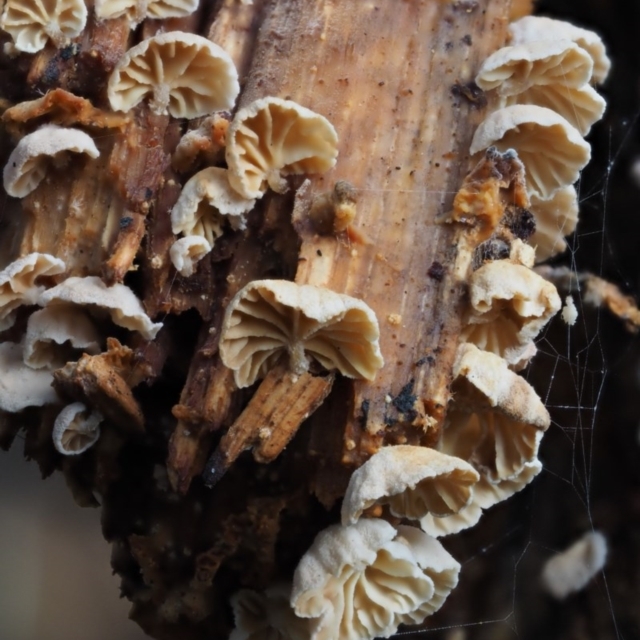Marasmiellus affixus (Little Stinker)
The fruitbody is a white to cream mushroom. The cap may be up to a centimetre or so in diameter (though often only half that). The fruitbody commonly grows out almost fan-like from its woody substrate so that the stem is almost horizontal and, unless you look from below, you might overlook it and assume the fruitbody is only a cap attached directly to the wood.
There is neither a universal nor a partial veil.
Spore print: white.
The mushrooms are often found in large numbers on the bark of live eucalypts. This species is nicknamed ‘Little stinker’ on account of its foetid odour (though perception of this varies between people).
Is Marasmiellus affixus a lichen?
It has been claimed that this is a lichenized species and you see it included in lichen checklists. However, while you see the mushrooms growing from algal covered wood the lichen association has never been proven. The species is discussed in https://www.anbg.gov.au/lichen/case-studies/marasmiellus-affixus.html. That brief account presents all the ostensible evidence of lichenization known by the early 21st century, none of which presents proof of a morphological connection between alga and fungus.
Since the appearance of that web page the two papers listed below have referred to Marasmiellus affixus and lichenization. Oberwinkler published various studies on basidiolichens and on page 353 of his 2012 review paper (an updated version of the 2001 paper cited in the above web page) says: “To my knowledge, M. affixus has never been studied in detail morphologically or molecularly”. Cooper & Leonard (p 43) write:
Another very distinctive character common to all three Gymnopus species ... is the presence of a waxy layer of partially gelatinised hyphae on the substrate from which the fruitbodies emerge. This layer is usually green from the presence of embedded algal cells...Detailed examination of our material does show algal cells deeply embedded within the context of the waxy layer and the basal portion of the stipe, but it would seem unlikely that algal cells are present in sufficient numbers to confer any significant nutritional benefit to the fungus. The morphologically similar Marasmiellus affixus ... is also associated with a waxy algae-infected layer ... A partial, poor quality ITS1 sequence for M. affixus obtained during this work (not deposited) suggests it has affinity with Marasmiellus ramealis ... rather than the taxa treated here.
As with Marasmiellus affixus, the three Gymnopus species grow with algae but the authors are cautious and do not claim lichenization. A search for information about Marasmiellus ramealis found no claims of lichenization for that species. The best way to answer the above question is: lichenisation in Marasmiellus affixus is plausible but not proven.
References
Cooper, J.A. & Leonard, P.L. (2013). Three new species of foetid Gymnopus in New Zealand, MycoKeys, 7, 31-44.
Oberwinkler, F. (2012). Basidiolichens, Chapter 16 (=pp 341-362) in Hock, B (ed.) The Mycota IX: Fungal Associations (2nd. ed), Springer, Berlin.
Marasmiellus affixus is listed in the following regions:
Canberra & Southern Tablelands | South Coast
Species information
- Marasmiellus affixus Scientific name
- Little Stinker Common name
- Not Sensitive
- Local native
- Non-invasive or negligible
- Machine learning














